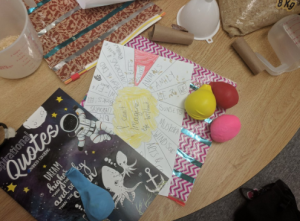I am a huge science fiction fan and was excited to start the new TV series “Brave New World”. I read the book for my “The Science in Science Fiction Literature” course (I know, cool course right?) in University and I was looking forward to the TV series. In the futuristic “Brave New World”, society has developed mood altering drugs that everyone is required to take to maintain their “levels” so that they can have calm, happy dispositions all of the time. The result is that the characters don’t really have to “feel” anything deeply. If there is discomfort or grief they can take a “soma” from their Pez dispenser-type tool and go on with life in peace and harmony. The struggle for the characters is that once they discover the power of feeling true human emotion they want to experience it, thus going against the social norm.
The “Brave New World” narrative parallels the dangers of toxic positivity. Psychologygroup.com defines toxic positivity as: “the excessive and ineffective overgeneralization of a happy, optimistic state across all situations. The process of toxic positivity results in the denial, minimization, and invalidation of the authentic human emotional experience.” Think of it like too much of a good thing can be bad for you. Phrases like, “It could be worse,” or “Focus on the positive,” “Don’t worry, be happy,” may seem innocuous, but in fact reject, repress or deny negative emotions. The message is that it is not OK to feel anything except positive and happy.
So what does this have to do with education? First of all, teachers excel at wearing stress and being busy as a badge of honour. I’m guilty of doing it. I’ve heard myself say that I worked all weekend preparing for the upcoming week. We have established this as a norm in educational culture. Human beings work best when they give themselves time to rejuvenate. Teacher burn out is a real thing. I honestly think if I walked into a staff room and announced, “I totally relaxed all weekend and just read my novel.” I would face sneers and hear “Must be nice,” muttered around me. Not because teachers are bad people, but because as a culture we don’t value taking care of ourselves as much as we value productivity. Being positive about being overworked and stressed out is toxic positivity, and it is rampant in education.
The problem isn’t with genuinely upbeat and effusive people. Those people are rare. Treasure them. The problem lies in people denying, repressing, minimizing or invalidating negative emotions. Keeping calm and carrying on can be counterproductive and harmful to mental health. While there are well intentioned people providing “just do it” kind of strategies and messages about being positive; those intentions may end up making people feel bad about feeling bad, adding guilt and shame to the mix of emotions.
So, what can we do? We can try to shift the narrative to value and validate the real emotions that people are feeling. We can try to give ourselves permission to say, “You know what, I’m not ok right now. I’m grieving the way in which I used to work and live. I’m hoping that it will soon change.” It is OK to be sad and yet still feel positive about the future. You can feel both things.
When someone shares their sadness, anger, grief or frustration with you, try to sincerely validate those emotions. True empathy is saying, “I’m here to embrace the suck with you,” not minimizing the emotions of others. You can be curious and ask questions, “That must be frustrating, tell me more about that, I’m here to listen.” Then, do that. Just listen.
I try to give myself grace and forgiveness. I have not learned to knit, bake bread or trained to run a marathon during the pandemic. Some days, just putting two feet on the carpet beside my bed is a big win. I have to remind myself daily that is OK not to be the “Quarantine Queen.” It is OK not to be productive beyond my wildest imagination during a global pandemic. I try to avoid offering platitudes about positivity. I try to validate the feelings of the people around me. I will try to give up “soma” in my Brave New Covid-19 World, throw out the fake positivity, and feel all of the range of emotions – good, bad and ugly.


 When building out toolkits, students used ideas from our discussions and activities from our sessions together to help build their own physical kits. We started off with ziploc bags and students decorated them with duct tape. This really was an idea from one of the students who had used it in the past to create her own pencil cases and she thought it would be a great – and inexpensive – way to personalize our own toolkits. Once the toolkits were designed, it was time to think about the items that they wanted to include.
When building out toolkits, students used ideas from our discussions and activities from our sessions together to help build their own physical kits. We started off with ziploc bags and students decorated them with duct tape. This really was an idea from one of the students who had used it in the past to create her own pencil cases and she thought it would be a great – and inexpensive – way to personalize our own toolkits. Once the toolkits were designed, it was time to think about the items that they wanted to include.  Wellness Journal
Wellness Journal